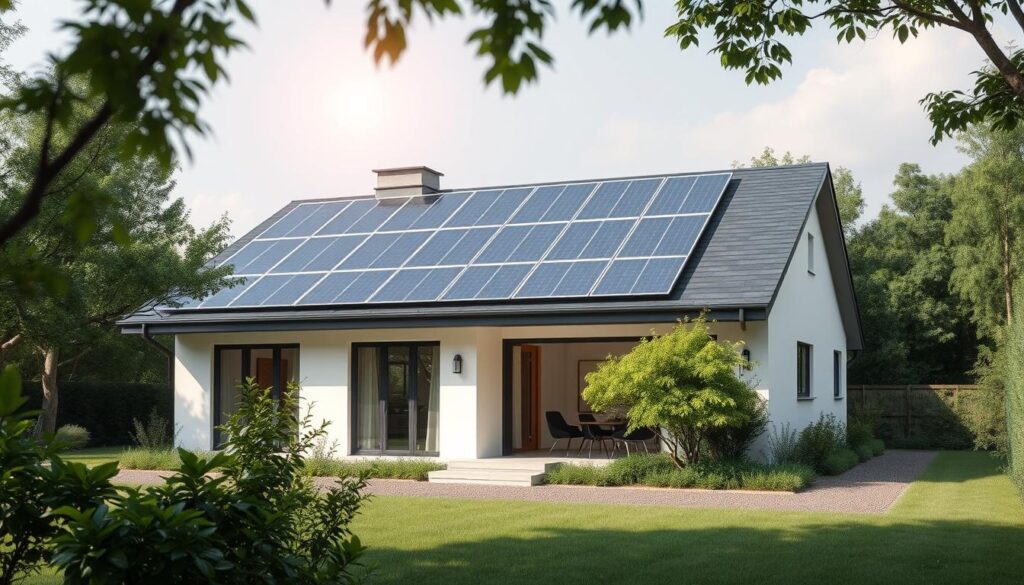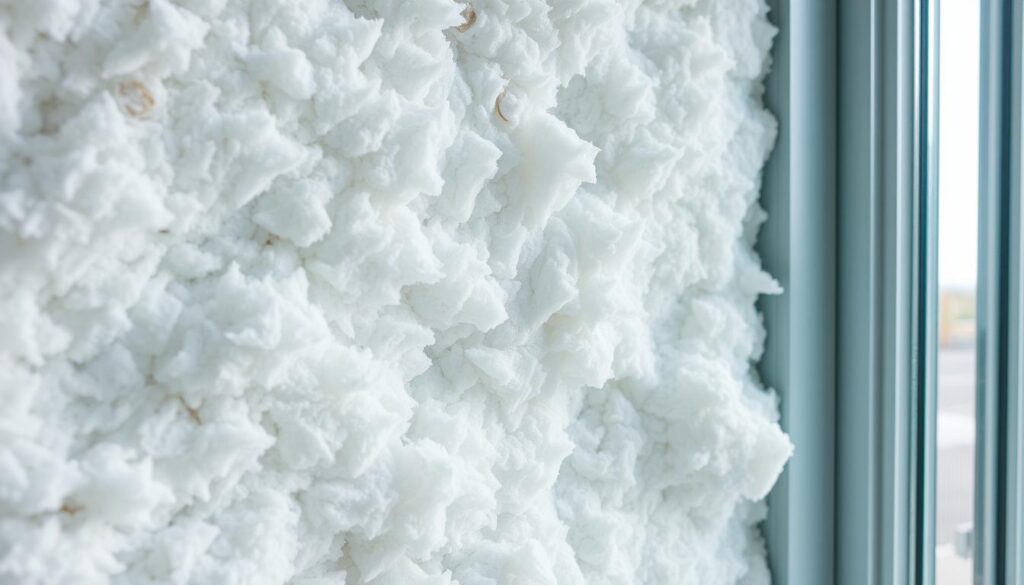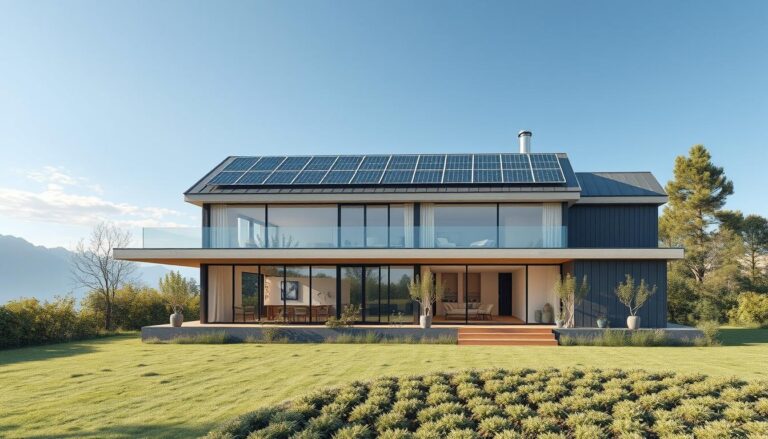Are we missing the key to fighting climate change? Exploring energy-efficient homes shows their huge potential. They cut energy bills and lower our carbon footprint.
These homes are the top choice for sustainable living, blending new tech with green building. They use passive solar design and top-notch insulation to use less energy. With our planet facing big challenges, moving to these smart homes is vital for a green future.
Key Takeaways
- Energy-efficient homes significantly reduce energy consumption and costs
- Sustainable housing incorporates advanced technologies and green building techniques
- Eco-friendly construction practices are crucial for reducing carbon footprints
- Smart living solutions offer both environmental and financial benefits
- The transition to energy-efficient homes is essential for a sustainable future
Understanding Energy-efficient Homes
Energy-efficient homes are key to sustainable living. They use less energy and support green building. Let’s explore what makes these homes important for our future.
Definition and Importance
These homes use less energy to stay comfortable like traditional houses. They have features that save energy and use resources wisely. They are vital in fighting climate change and high energy costs.
Key Features of Energy-efficient Homes
Energy-efficient homes have many important features:
- High-performance insulation
- Energy-efficient windows and doors
- Efficient heating and cooling systems
- LED lighting
- Smart home technology
Benefits for Homeowners and the Environment
Energy-efficient homes help both homeowners and the planet:
| Homeowner Benefits | Environmental Benefits |
|---|---|
| Lower utility bills | Reduced carbon emissions |
| Improved indoor air quality | Conservation of natural resources |
| Enhanced comfort | Less strain on power grids |
| Increased property value | Promotion of sustainable living |
Choosing energy-efficient homes saves money and helps the planet. It’s a smart way to invest in a greener future for all.
Green Building Techniques for Sustainable Housing
Green building techniques are changing the way we build homes. They make houses use less energy and are better for the planet. Let’s look at some important methods that are making a big difference in building homes sustainably.
Using sustainable materials is key in green building. Recycled steel, bamboo, and reclaimed wood are great choices. They are better for the environment and last longer than traditional materials. Saving water is also important.
Low-flow fixtures and systems that collect rainwater can cut water use by half.
Reducing waste is a big part of eco-friendly building. Recycling on-site and ordering materials carefully helps reduce trash. Some builders even turn construction waste into new building parts, helping the economy circle back on itself.
| Green Building Technique | Environmental Benefit | Cost Savings |
|---|---|---|
| Solar Panel Installation | Reduces reliance on fossil fuels | Up to 70% on energy bills |
| High-Performance Insulation | Lowers energy consumption | 20-30% on heating/cooling costs |
| Green Roofs | Improves air quality, reduces urban heat island effect | 15-25% on cooling costs |
These green building methods help make homes sustainable and save money over time. By using these methods, we’re building a future where living comfortably and taking care of the planet go together.
Passive House Design: Maximizing Natural Energy
Passive house design is key to making homes use less energy. It uses nature to keep homes warm or cool, cutting down on energy use.
Principles of Passive House Design
Passive house design has core principles:
- Superinsulation to prevent heat loss
- Airtight construction to eliminate drafts
- High-performance windows for optimal solar gain
- Balanced ventilation systems for fresh air
- Thermal bridge-free design to avoid heat transfer
Implementing Passive Strategies in Home Construction
Building sustainable homes means placing them to get lots of sunlight. This cuts down on heating in winter. I add thick insulation to walls, floors, and roofs to keep temperatures steady.
Triple-pane windows also help save energy.
Case Studies of Successful Passive Houses
The Smith Residence in Oregon is a great example of passive house design. It uses 90% less energy than usual homes. The house faces the sun to get sunlight, but has shades to keep it cool in summer.
The design is airtight, and a special system brings in fresh air. This keeps the house comfortable all year.
| Feature | Standard Home | Passive House |
|---|---|---|
| Annual Energy Use | 100 kWh/m² | 15 kWh/m² |
| Heating Costs | $1,500/year | $150/year |
| CO2 Emissions | 5 tons/year | 0.5 tons/year |
Passive house design shows us that homes can be both cozy and good for the planet. By using these ideas, we can make homes that are better for everyone and the earth.
Zero-Net Energy Homes: The Ultimate Goal
Zero-net energy homes are the top goal in energy efficiency. They make as much energy as they use in a year, balancing their energy use. I’ve seen how these homes use the latest technology and smart design for great efficiency.

These homes focus on managing energy well. They use top-notch insulation, windows, and are built tightly to lose less energy. They also have smart heating, cooling, and ventilation to use less energy.
Using renewable energy is key in these homes. Solar panels are common, but some use wind turbines or geothermal systems too. This mix of saving and making energy makes living sustainable.
“Living in a zero-net energy home has transformed my perspective on sustainable living. It’s not just about saving money; it’s about creating a better future for our planet.”
Zero-net energy homes are good for the planet and for people. Owners pay less for utilities and their homes are worth more. These homes also make living more comfortable and the air cleaner, making life better.
| Feature | Benefit |
|---|---|
| Solar Panels | Clean energy production |
| Advanced Insulation | Reduced energy loss |
| Smart Home Systems | Optimized energy use |
| Energy-efficient Appliances | Lower electricity consumption |
As technology gets better and costs go down, zero-net energy homes are easier to get. They show the future of living sustainably and set a high standard for energy-efficient homes in the U.S.
LEED Certification: Setting the Standard for Energy-efficient Homes
LEED certification is now the top choice for energy-efficient homes and green building. I’ve seen how it changes our approach to sustainable living.
Understanding LEED Certification Levels
LEED has four levels for energy-efficient homes: Certified, Silver, Gold, and Platinum. Each level needs a certain number of points. These points come from sustainable features and practices.
| Certification Level | Points Required | Key Features |
|---|---|---|
| Certified | 40-49 | Basic energy efficiency measures |
| Silver | 50-59 | Advanced insulation, water conservation |
| Gold | 60-79 | Renewable energy integration, smart home technology |
| Platinum | 80+ | Net-zero energy consumption, innovative green solutions |
The Certification Process
To get LEED certification, start by registering your project with the U.S. Green Building Council. Then, design and build your home with LEED in mind. Finally, send in your documents for review and get certified.
Benefits of LEED Certification for Homeowners
LEED-certified homes have many benefits. They use less energy, which means lower bills. These homes also have better air quality inside, making them healthier to live in. Plus, they often have higher resale values, making them a smart choice for the future.
“My LEED-certified home has cut my energy bills in half while providing a more comfortable living environment. It’s a win-win for my wallet and the planet.”
Energy-saving Features for Modern Homes
I’ve learned that energy-saving features are key for making homes more efficient and promoting smart living. These technologies cut down on utility bills and help the environment too.
Smart thermostats change the game in managing home energy. They learn what you like and adjust the temperature for you. This means you’re always comfortable and use less energy. I’ve seen these devices save up to 15% on heating and cooling costs.
Energy-efficient appliances are vital for modern homes. Products with the ENERGY STAR label use way less electricity than others. For instance, an ENERGY STAR fridge uses 15% less power than others.
LED lighting is a great way to save energy too. These bulbs use 75% less power and last much longer than old bulbs. Switching to LEDs has cut my electricity bills a lot.
Advanced HVAC systems are key for efficient homes. Variable-speed air conditioners and heat pumps adjust their power as needed. This makes your home more comfortable and saves energy.
| Energy-saving Feature | Potential Energy Savings | Lifespan |
|---|---|---|
| Smart Thermostats | 10-15% on HVAC costs | 10-15 years |
| ENERGY STAR Appliances | 10-50% depending on appliance | 10-20 years |
| LED Lighting | 75% compared to incandescent | 25,000-50,000 hours |
| Advanced HVAC Systems | 20-30% on heating/cooling | 15-20 years |
By using these energy-saving features, homeowners can cut their carbon footprint. They also enjoy the perks of living in efficient homes.
Integrating Renewable Energy Sources in Residential Buildings
Renewable energy is changing the game for energy-efficient homes. I’ve seen how sustainable housing changes our living spaces. Let’s dive into the exciting ways we can use clean energy at home.
Solar Power Systems for Homes
Solar panels are popping up on roofs all over America. They turn sunlight into electricity, making our homes run on clean energy. Homeowners often see their energy bills drop over time with solar setups.
Wind Energy Solutions for Residential Use
Small-scale wind turbines are getting more popular, especially in rural areas. They can make a lot of power when there’s steady wind. I’ve seen more people looking into this as tech gets better and prices go down.
Geothermal Heating and Cooling Systems
Geothermal systems use the earth’s steady temperature to heat and cool homes. They move fluid through underground pipes to bring heat in or take it out, depending on the season. It’s a smart way to control the climate in eco-friendly homes.
| Renewable Energy Source | Initial Cost | Energy Savings | Maintenance |
|---|---|---|---|
| Solar Power | High | 50-90% on electricity | Low |
| Wind Energy | Medium | 30-60% on electricity | Medium |
| Geothermal | High | 30-70% on heating/cooling | Low |
Adding these renewable energy sources to our homes is a big step towards a sustainable future. As technology gets better, I’m looking forward to seeing how energy-efficient homes will keep evolving and impacting our communities.
High-Performance Insulation: The Key to Energy Efficiency
High-performance insulation is key for energy-efficient homes. It helps cut down energy costs and makes homes more comfortable. Choosing the right insulation materials and installing them correctly are crucial for the best results.

Insulation types like cellulose, fiberglass, and spray foam work well for different needs. Cellulose is good for attics and is eco-friendly. Spray foam is great for filling in hard spots.
Getting insulation installed right is as important as picking the right material. I always suggest hiring experts to make sure it’s done correctly. This ensures no gaps or compression that could lower its effectiveness. Such care can greatly improve a home’s energy efficiency.
| Insulation Type | R-Value per Inch | Best Use |
|---|---|---|
| Cellulose | 3.2 – 3.8 | Attics, walls |
| Fiberglass | 2.2 – 2.7 | Walls, floors |
| Spray Foam | 3.6 – 6.5 | Hard-to-reach areas |
In my work, high-performance insulation has led to energy savings of up to 50%. This cuts down on utility bills and makes homes more comfortable. It keeps temperatures steady and reduces drafts.
“Investing in quality insulation is like giving your home a cozy sweater – it keeps the warmth in and the cold out, all while saving you money.”
By focusing on high-performance insulation, we can make homes more energy-efficient. This helps both homeowners and the environment. It’s a key part of building green homes that we shouldn’t ignore.
Conclusion
Energy-efficient homes are the future of smart living. This article has covered various aspects of sustainable housing. We’ve looked at green building and passive house design.
These innovations are changing how we build homes and use energy. The benefits of these homes go beyond saving on bills. They make living spaces healthier, reduce harm to the environment, and can even increase property values.
By using renewable energy and better insulation, homeowners can lower their carbon footprint. They also get to enjoy a more comfortable living space.
As we aim for a sustainable future, I urge everyone to think about making their homes more energy-efficient. Whether you’re building a new home or updating an old one, there are many ways to make it better. By choosing these smart living solutions, we can help make the world a greener place, one home at a time.



